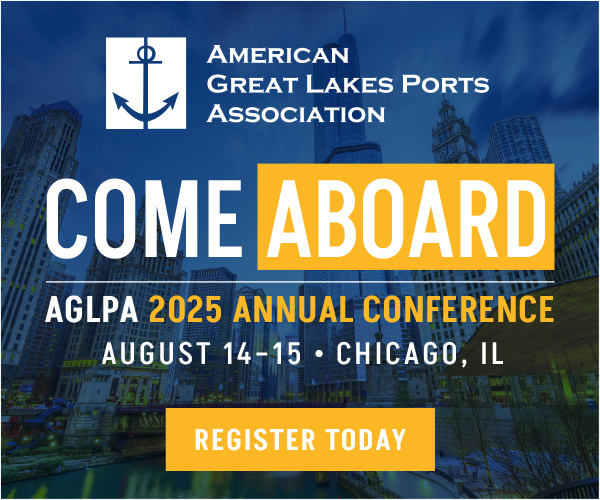MARAD Awards Grants to Eight Marine Highway Projects, Including One in Wisconsin
United States Marine Highway grants can be used to purchase low-emission U.S.-manufactured equipment, such as container reach stackers and cranes, with the condition that all iron, steel, manufactured products, and construction materials are produced in the United States. In addition, funds can be used to purchase intermodal equipment that can alleviate supply chain bottlenecks.
In Wisconsin, Lake Michigan Carferry, Inc. was awarded $600,000 to support a zero-emission/carbon capture feasibility analysis to convert the SS Badger from a coal-fired steamship to a zero-emission ferry vessel. The project will facilitate the safe, sustainable, and efficient transfer movement of three types of freight: traditional semi-trailers, oversize loads, and project cargo. The service offers customers a more economical and efficient transportation route which allows truckers to avoid a 350-mile trip through Chicago on the heavily congested I-90. As the last coal-powered freight and passenger ferry in the United States, this project will embrace clean energy and support the United States Marine Highway Program’s initiative of reducing emissions.
Other projects receiving funding include:
- The Matanuska-Susitna Borough in Alaska was awarded $944,804 for the acquisition of a 75-ton rough terrain crane for loading and unloading cargo, freight, fuel, equipment, and other goods at Port MacKenzie. The versatility of the crane will provide needed accommodations for handling heavy freight and cargo at the deep-draft dock, the barge dock, and the bow ramp. This project is strategically located in the Upper Cook Inlet, with Fairbanks to the north and Anchorage to the south. It provides resiliency and redundancy for unforeseen natural disasters or emergencies that could negatively impact other modes of transportation.
- The Kaskaskia Regional Port District in Illinois was awarded $1,008,750 for the acquisition of eight shuttle cars, which are the final component needed to complete the infrastructure expansion at the Kaskaskia Regional Port District, which will handle 2.25 million tons of new coiled steel and move existing coiled steel located at the terminal to a new laydown yard. Rail infrastructure will be provided via a state freight grant, which was approved by the Governor of Illinois in the spring of 2023. The service will eliminate 3.8 million to 4.8 million truck miles annually, including overweight loads, which will significantly reduce the physical impact on local roads and bridges.
- The Ports of Indiana was awarded $2,250,000for the acquisition of a new crane for the Ports of Indiana-Mount Vernon. The crane more than doubles the port’s lift capacity from less than 60 tons to 120 tons and allows the Port to supply heavy lift transload between barge, rail, and truck. The procurement of a modern, safer, more reliable, and environmentally friendly crane will enable the Ports of Indiana-Mount Vernon to decrease emissions and reduce pollution. This project builds off two existing United States Marine Highway Grant-funded projects involving NUCOR steel. The new crane will remove large and overweight steel plate shipments leaving NUCOR’s Brandenburg, KY facility.
- The Morgan City Harbor and Terminal District in Louisiana was awarded $3,320,000 for the procurement, delivery, and assembly of cargo transloading equipment, specifically a 220-ton crane and a 25-ton forklift. Procuring modern and efficient cargo transloading equipment will improve efficiency and safely mitigate congestion by providing benefits to time-savings, fuel efficiency, safety, and reducing carbon emissions. The project promotes the establishment of a marine highway transportation service located on United States Marine Highway Route M-49 between the Port of Morgan City and central/northern Louisiana ports located on the Atchafalaya River and Red River.
- The Port of Beaumont Navigation District of Jefferson County, Texas was awarded $2,041,925 for the acquisition of two reach stackers, which will be used as the primary equipment for cargo movements associated with the Port of Beaumont Container on Barge Service from the Port of Beaumont to Port Houston. This project will reduce barriers for domestic producers to ship products abroad, decrease emissions associated with trucking products to Houston, and provide safety and maintenance benefits by reducing vehicle miles traveled. This project also has the potential to create a modal shift promoting resiliency and redundancy in the freight movement system via utilization of United States Marine Highway Routes M-69 and M-10. United States manufacturers will now be able to use waterways as an alternative to existing truck and rail systems to transport containers.
- The state of Washington’s Port of Bellingham was awarded $1,021,747 for the purchase of a portable barge ramp for the Bellingham Shipping Terminal (BST) to support the movement of lumber, refrigerated and non-refrigerated containers, rolling stock, and household goods between the Port of Bellingham and Port of San Diego as part of the United States Marine Highway Route M-5. The new barge service reduces truck and rail shipments between BST and the Port of San Diego, improving environmental sustainability by using less energy and reducing air emissions per ton-mile of freight moved.
- SeaTac Marine Services, LLC (STMS) in Washington was awarded $811,965for the acquisition of a Tier 4 forklift for Alaska-bound cargo. The forklift is an upgrade to existing equipment and enables STMS to maximize its terminal capacity through efficiencies gained with modern low-emission equipment. This project will improve service between the SeaTac terminal in Seattle and the Port of Anchorage along United States Marine Highway Route M-5.

MarAd Expands Inland Waterways
U.S. Department of Transportation Secretary Sean P. Duffy has announced the Maritime Administration (MarAd) has designated 848 new miles of navigable waterways and approved 14 new sponsors for the U.S.... Read More

GLMA Cadets Train on New Vessel Robinson Bay
NMC Great Lakes Maritime Academy cadets will begin training this week aboard the donated tugboat Robinson Bay, the first vessel the academy has acquired in more than 20 years, expanding... Read More




